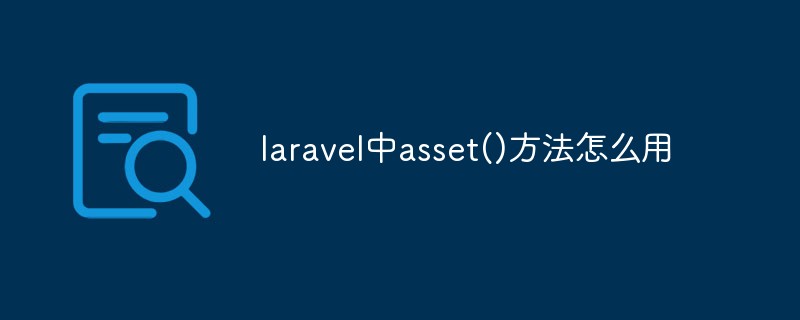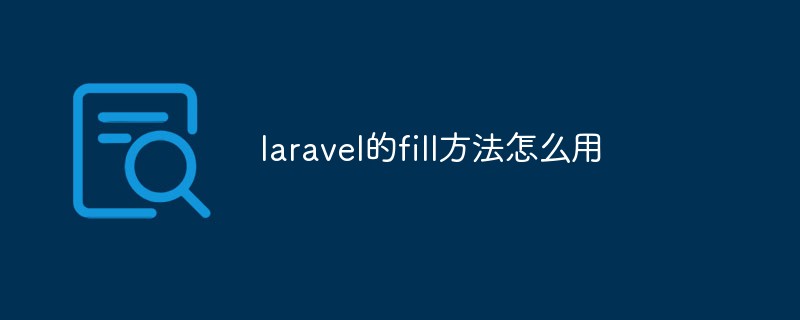How to modify .env in laravel: 1. Obtain the path of the env file through "base_path('.env');"; 2. Declare through "function updateEnv($data = array()){}" Function; 3. Modify and parse the env file through "$pattern = '/([^\=]*)\=[^\n]*/';" regular matching.

The operating environment of this tutorial: Windows 7 system, Laravel version 5.7, Dell G3 computer.
How to modify .env in laravel?
Laravel dynamically modifies the value of the env environment variable!
Introduction
In order to separate the configuration parameters to distinguish the development environment, online environment and other functions, or manually switch the cache driver, queue driver, mail server address, Etc., etc., these can be easily labeled. So laravel uses .env files to wrap these configuration data, which are key-value pairs.
Learning time
Under normal circumstances, we are not allowed to modify the content of the env file unless it is processed manually. However, in programming, it is inevitable to encounter situations that must be modified. So how to dynamically operate the key-value pairs in the env file?
Assume that the APP_KEY generated by the system using key:generate is not safe. When doing automated deployment and batch deployment, there is a need to dynamically modify the APP_KEY key. How to achieve this?
In fact, the env file is just a text file, written in a standard format such as key=value, using string matching throughout, with a single line until the newline character stops.
Then modifying the content of the env file is nothing more than finding the relevant key and then replacing the value, that's it.
The first version is given below, which is the simple and crude file_put_contents. First get the path of the env file:
$path = base_path('.env');
Need to determine whether the file exists:
if (file_exists($path)){
// 文件存在
}The file exists Then first read all the contents of the file into a string variable:
$origin = file_get_contents($path);
Assume that our new APP_KEY exists in the variable $new_key, first get the original APP_KEY value:
$old_key = env('APP_KEY');
String Of course, the operation requires direct matching using the string replacement function. We use str_replace. After all, the amount of data in the env file is not large, so there is no big performance problem.
$result = str_replace('APP_KEY=' . $old_key, $new_key, $origin);
In this way, the value of the latest env file is stored in $result. Then just write the env file:
file_put_contents($result);
The default is to overwrite, so after executing the program, the env file will be The latest dynamically modified data.
Go deeper
The above code is still flawed, because there is basically no error handling, which can easily cause errors. In addition, for file operations as important as env, directly using string replacement to read and overwrite the entire file is inherently risky.
How to transform our operation methods to make them safer? We need more compatible code. In this section, we try to use regular matching to parse the env file, read it line by line, operate it line by line, and judge it line by line. If the key value exists, it will be overwritten; if it does not exist, it will be created. In this way, it can be compatible with both new and update functions, and the supported key values are more flexible.
Encapsulated as a helper function, assuming that the parameter passed in is an array and an associative array. Declare the function as follows:
function updateEnv($data = array()){}Writing logic in the function body, first check if it is not empty:
if (! count($data)) {return;}If it is not an associative array, it is also not accepted, because the env file must clearly specify the key and value. For associative arrays, you only need to determine that the keys of the array are different from the automatically serialized keys:
if (array_keys($data) === range(0, count($data) - 1)) {return;}Prepare the matching pattern:
$pattern = '/([^\=]*)\=[^\n]*/';
This is the format for writing the env file. We have already introduced it in the previous section. We read the old env file into an array and declare a new array to store the latest configuration file data:
$envFile = base_path() . '/.env'; $lines = file($envFile); $newLines = [];
Then traverse the old file data and parse it line by line:
foreach ($lines as $line) {
preg_match($pattern, $line, $matches);
if (!count($matches)) {
$newLines[] = $line;
continue;
}
if (!key_exists(trim($matches[1]), $data)) {
$newLines[] = $line;
continue;
}
$line = trim($matches[1]) . "={$data[trim($matches[1])]}\n";
$newLines[] = $line;
}Above This is just a rough processing flow. This parsing process can be independently customized as a custom function or other parsing engines, so it is universal.
Finally, write the new parsed data completely into the env file:
$newContent = implode('', $newLines); file_put_contents($envFile, $newContent);
At this point, the update operation of the env file is completed.
Written at the end
This article implements the function of dynamically creating and updating env global configuration file data in the program in two ways. The second method has better fault tolerance and versatility. , has strong scalability, so we recommend it. The first approach has no error handling and is almost unusable in a production environment. It would be great if everyone knew the idea.
Recommended learning: "laravel video tutorial"
The above is the detailed content of How to modify .env in laravel. For more information, please follow other related articles on the PHP Chinese website!
 laravel单点登录方法详解Jun 15, 2022 am 11:45 AM
laravel单点登录方法详解Jun 15, 2022 am 11:45 AM本篇文章给大家带来了关于laravel的相关知识,其中主要介绍了关于单点登录的相关问题,单点登录是指在多个应用系统中,用户只需要登录一次就可以访问所有相互信任的应用系统,下面一起来看一下,希望对大家有帮助。
 一起来聊聊Laravel的生命周期Apr 25, 2022 pm 12:04 PM
一起来聊聊Laravel的生命周期Apr 25, 2022 pm 12:04 PM本篇文章给大家带来了关于laravel的相关知识,其中主要介绍了关于Laravel的生命周期相关问题,Laravel 的生命周期从public\index.php开始,从public\index.php结束,希望对大家有帮助。
 laravel中guard是什么Jun 02, 2022 pm 05:54 PM
laravel中guard是什么Jun 02, 2022 pm 05:54 PM在laravel中,guard是一个用于用户认证的插件;guard的作用就是处理认证判断每一个请求,从数据库中读取数据和用户输入的对比,调用是否登录过或者允许通过的,并且Guard能非常灵活的构建一套自己的认证体系。
 laravel中asset()方法怎么用Jun 02, 2022 pm 04:55 PM
laravel中asset()方法怎么用Jun 02, 2022 pm 04:55 PMlaravel中asset()方法的用法:1、用于引入静态文件,语法为“src="{{asset(‘需要引入的文件路径’)}}"”;2、用于给当前请求的scheme前端资源生成一个url,语法为“$url = asset('前端资源')”。
 实例详解laravel使用中间件记录用户请求日志Apr 26, 2022 am 11:53 AM
实例详解laravel使用中间件记录用户请求日志Apr 26, 2022 am 11:53 AM本篇文章给大家带来了关于laravel的相关知识,其中主要介绍了关于使用中间件记录用户请求日志的相关问题,包括了创建中间件、注册中间件、记录用户访问等等内容,下面一起来看一下,希望对大家有帮助。
 laravel中间件基础详解May 18, 2022 am 11:46 AM
laravel中间件基础详解May 18, 2022 am 11:46 AM本篇文章给大家带来了关于laravel的相关知识,其中主要介绍了关于中间件的相关问题,包括了什么是中间件、自定义中间件等等,中间件为过滤进入应用的 HTTP 请求提供了一套便利的机制,下面一起来看一下,希望对大家有帮助。
 laravel的fill方法怎么用Jun 06, 2022 pm 03:33 PM
laravel的fill方法怎么用Jun 06, 2022 pm 03:33 PM在laravel中,fill方法是一个给Eloquent实例赋值属性的方法,该方法可以理解为用于过滤前端传输过来的与模型中对应的多余字段;当调用该方法时,会先去检测当前Model的状态,根据fillable数组的设置,Model会处于不同的状态。
 laravel路由文件在哪个目录里Apr 28, 2022 pm 01:07 PM
laravel路由文件在哪个目录里Apr 28, 2022 pm 01:07 PMlaravel路由文件在“routes”目录里。Laravel中所有的路由文件定义在routes目录下,它里面的内容会自动被框架加载;该目录下默认有四个路由文件用于给不同的入口使用:web.php、api.php、console.php等。


Hot AI Tools

Undresser.AI Undress
AI-powered app for creating realistic nude photos

AI Clothes Remover
Online AI tool for removing clothes from photos.

Undress AI Tool
Undress images for free

Clothoff.io
AI clothes remover

AI Hentai Generator
Generate AI Hentai for free.

Hot Article

Hot Tools

SAP NetWeaver Server Adapter for Eclipse
Integrate Eclipse with SAP NetWeaver application server.

Dreamweaver Mac version
Visual web development tools

ZendStudio 13.5.1 Mac
Powerful PHP integrated development environment

Atom editor mac version download
The most popular open source editor

SublimeText3 Linux new version
SublimeText3 Linux latest version






